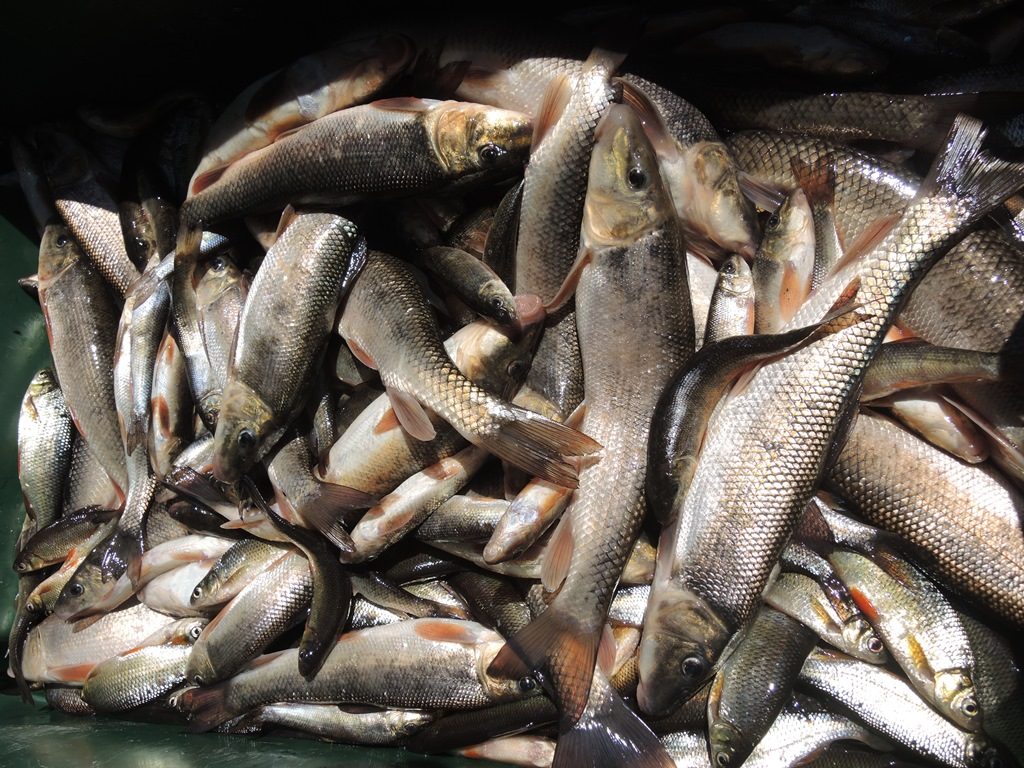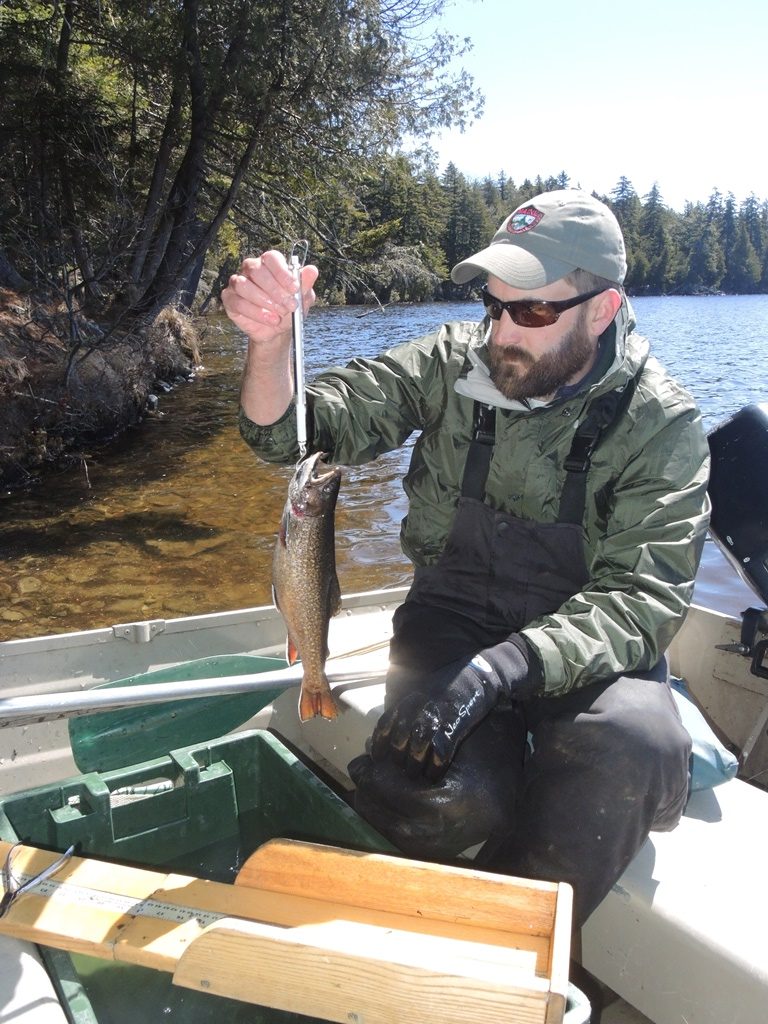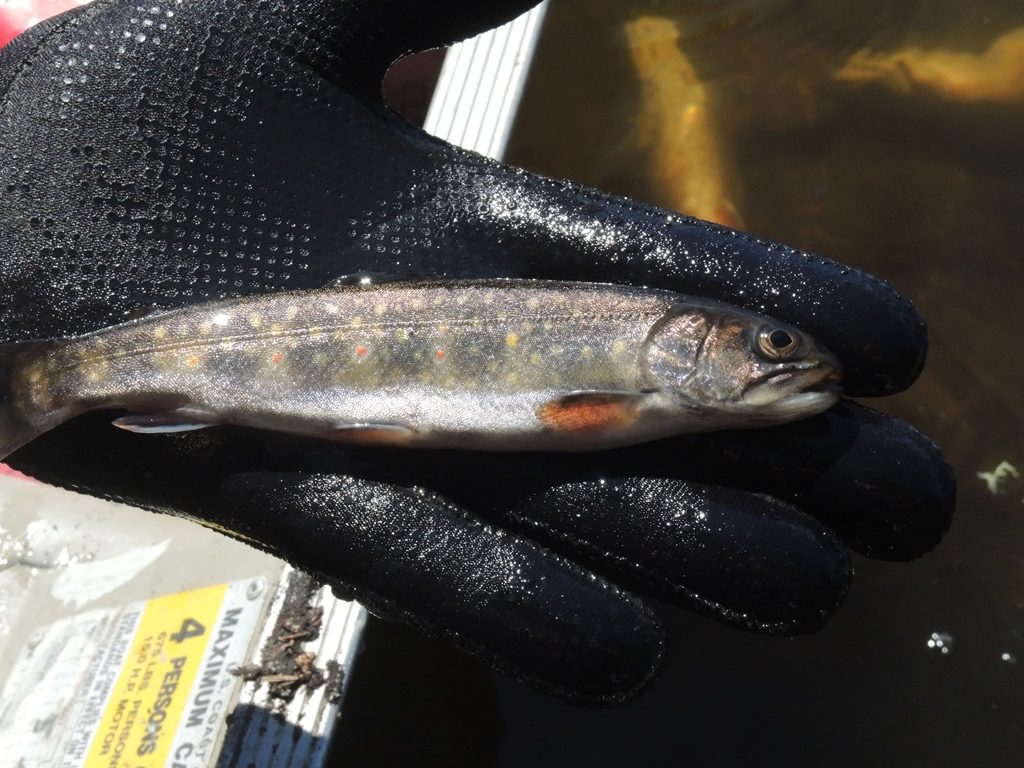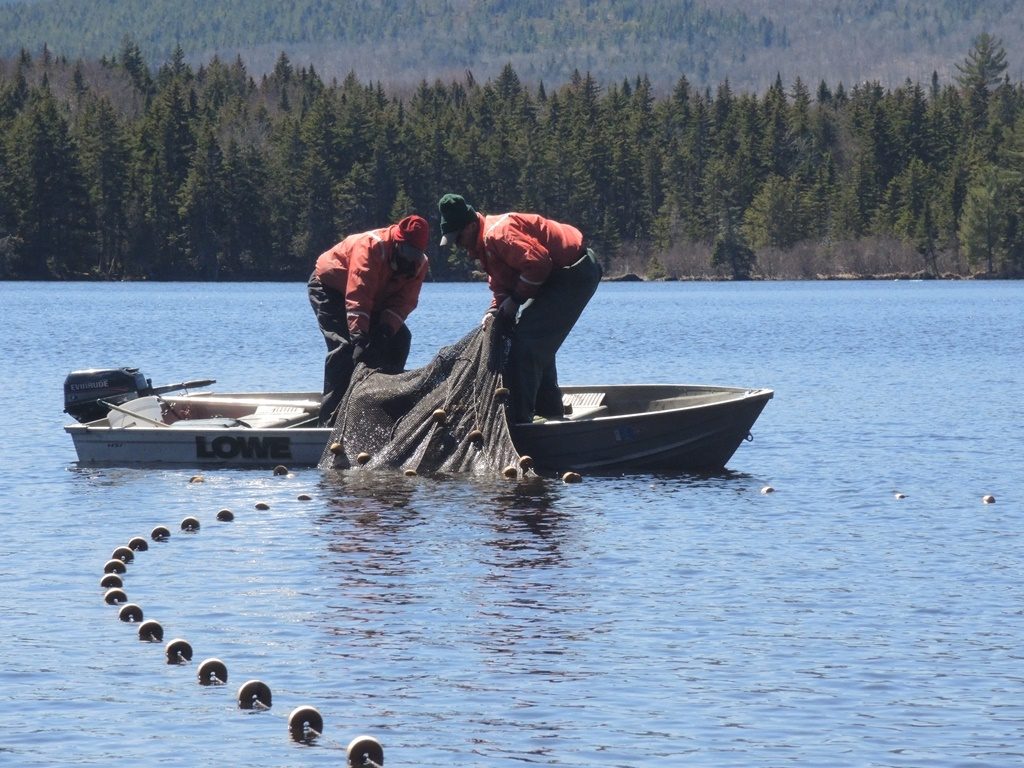May 27, 2016 at 12:21 pm
[caption id="attachment_1524" align="alignright" width="578"] Removing the suckers and shiners from a native trout pond allow the brook trout to flourish.[/caption]
Wonder what can happen when you remove nearly two tons of suckers and shiners from a small, 73-acre native trout pond? Brook trout flourish.
Fisheries management can take many different forms. For some lakes or ponds, all it may take to improve the fishing is a tweak in a regulation or an adjustment on how many fish are stocked.
However, in some ponds where trout compete with suckers, baitfish and other native fishes, it is not as simple. There is only a certain amount of food in the pond, and if trout are competing with suckers and shiners for that limited amount of food, the trout are going to suffer.
What can IFW Fisheries biologists do to improve the trout fishery in a native trout pond that is shared by competing species? IFW fisheries biologist Tim Obrey showed that by manually removing the competing species in a small pond, you can boost and improve the trout population and the fishing.
Little Moxie pond is located southeast of a Greenville. Between 1994 and 2001 biologists netted the pond in order to assess the effects of more restrictive trout regulations. However, while using the trapnets to catch trout, as a side project, they started removing the competing suckers, shiners, and occasional creek chub. Only brook trout were returned to the pond.
[caption id="attachment_1522" align="alignleft" width="375"]
Removing the suckers and shiners from a native trout pond allow the brook trout to flourish.[/caption]
Wonder what can happen when you remove nearly two tons of suckers and shiners from a small, 73-acre native trout pond? Brook trout flourish.
Fisheries management can take many different forms. For some lakes or ponds, all it may take to improve the fishing is a tweak in a regulation or an adjustment on how many fish are stocked.
However, in some ponds where trout compete with suckers, baitfish and other native fishes, it is not as simple. There is only a certain amount of food in the pond, and if trout are competing with suckers and shiners for that limited amount of food, the trout are going to suffer.
What can IFW Fisheries biologists do to improve the trout fishery in a native trout pond that is shared by competing species? IFW fisheries biologist Tim Obrey showed that by manually removing the competing species in a small pond, you can boost and improve the trout population and the fishing.
Little Moxie pond is located southeast of a Greenville. Between 1994 and 2001 biologists netted the pond in order to assess the effects of more restrictive trout regulations. However, while using the trapnets to catch trout, as a side project, they started removing the competing suckers, shiners, and occasional creek chub. Only brook trout were returned to the pond.
[caption id="attachment_1522" align="alignleft" width="375"] In the abscence of competing species, not only do the brook trout get larger, but there are more of them.[/caption]
Over the first two years, biologists removed over 3,400 pounds of suckers. That’s over one and half tons! Wonder what happened? The trout responded by filling the void left by the removal of the suckers. Trout got bigger, fatter, and there were more of them.
Consider this: In the first year of the study, it was estimated there were only 670 brook trout in the pond, and only four trout over 12 inches. Two years after the suckers were removed, the trout population doubled to over 1,300 trout with nearly 300 trout exceeding 12 inches and several over 16 inches.
Unfortunately, after two consecutive dry, hot summers, the trout population in this shallow pond plummeted to less than 60 trout in 2001. However, trout are nothing if not resilient and with the absence of the suckers in this pond, by 2006 the population had rebounded to over 1,000 trout.
Sadly, suckers are resilient too, and without any removal efforts since 2006, they rebounded and the trout population started to decline in size and quality. By 2013 with no more removal, the trout population declined to less than 600 fish.
Obrey and his fellow Moosehead Region fisheries biologists Jeff Bagley and Steve Seeback are back at it now, trapnetting trout to monitor the fishery, and removing competing species. In 2013 and 2014 they have removed over 3,300 pounds of suckers.
In the abscence of competing species, not only do the brook trout get larger, but there are more of them.[/caption]
Over the first two years, biologists removed over 3,400 pounds of suckers. That’s over one and half tons! Wonder what happened? The trout responded by filling the void left by the removal of the suckers. Trout got bigger, fatter, and there were more of them.
Consider this: In the first year of the study, it was estimated there were only 670 brook trout in the pond, and only four trout over 12 inches. Two years after the suckers were removed, the trout population doubled to over 1,300 trout with nearly 300 trout exceeding 12 inches and several over 16 inches.
Unfortunately, after two consecutive dry, hot summers, the trout population in this shallow pond plummeted to less than 60 trout in 2001. However, trout are nothing if not resilient and with the absence of the suckers in this pond, by 2006 the population had rebounded to over 1,000 trout.
Sadly, suckers are resilient too, and without any removal efforts since 2006, they rebounded and the trout population started to decline in size and quality. By 2013 with no more removal, the trout population declined to less than 600 fish.
Obrey and his fellow Moosehead Region fisheries biologists Jeff Bagley and Steve Seeback are back at it now, trapnetting trout to monitor the fishery, and removing competing species. In 2013 and 2014 they have removed over 3,300 pounds of suckers. This season, while netting multiple days over a 2 week period, they have removed over 14,000 white suckers, 2,900 golden shiners, and 123 creek chubs totaling 1,880 pounds.
The trout are responding. Early trapnetting returns are showing more and bigger trout, showing once again that intensive, focused fisheries management can have an extremely positive effect on native trout populations.
[caption id="attachment_1523" align="aligncenter" width="1024"]
This season, while netting multiple days over a 2 week period, they have removed over 14,000 white suckers, 2,900 golden shiners, and 123 creek chubs totaling 1,880 pounds.
The trout are responding. Early trapnetting returns are showing more and bigger trout, showing once again that intensive, focused fisheries management can have an extremely positive effect on native trout populations.
[caption id="attachment_1523" align="aligncenter" width="1024"] Trap nets are used to capture the fish. The suckers, shiners and creek chubs are removed from the water, while the trout are measured, weighed and released. Removing the competing species is beneficial to the native trout.[/caption]
Trap nets are used to capture the fish. The suckers, shiners and creek chubs are removed from the water, while the trout are measured, weighed and released. Removing the competing species is beneficial to the native trout.[/caption]
 Removing the suckers and shiners from a native trout pond allow the brook trout to flourish.[/caption]
Wonder what can happen when you remove nearly two tons of suckers and shiners from a small, 73-acre native trout pond? Brook trout flourish.
Fisheries management can take many different forms. For some lakes or ponds, all it may take to improve the fishing is a tweak in a regulation or an adjustment on how many fish are stocked.
However, in some ponds where trout compete with suckers, baitfish and other native fishes, it is not as simple. There is only a certain amount of food in the pond, and if trout are competing with suckers and shiners for that limited amount of food, the trout are going to suffer.
What can IFW Fisheries biologists do to improve the trout fishery in a native trout pond that is shared by competing species? IFW fisheries biologist Tim Obrey showed that by manually removing the competing species in a small pond, you can boost and improve the trout population and the fishing.
Little Moxie pond is located southeast of a Greenville. Between 1994 and 2001 biologists netted the pond in order to assess the effects of more restrictive trout regulations. However, while using the trapnets to catch trout, as a side project, they started removing the competing suckers, shiners, and occasional creek chub. Only brook trout were returned to the pond.
[caption id="attachment_1522" align="alignleft" width="375"]
Removing the suckers and shiners from a native trout pond allow the brook trout to flourish.[/caption]
Wonder what can happen when you remove nearly two tons of suckers and shiners from a small, 73-acre native trout pond? Brook trout flourish.
Fisheries management can take many different forms. For some lakes or ponds, all it may take to improve the fishing is a tweak in a regulation or an adjustment on how many fish are stocked.
However, in some ponds where trout compete with suckers, baitfish and other native fishes, it is not as simple. There is only a certain amount of food in the pond, and if trout are competing with suckers and shiners for that limited amount of food, the trout are going to suffer.
What can IFW Fisheries biologists do to improve the trout fishery in a native trout pond that is shared by competing species? IFW fisheries biologist Tim Obrey showed that by manually removing the competing species in a small pond, you can boost and improve the trout population and the fishing.
Little Moxie pond is located southeast of a Greenville. Between 1994 and 2001 biologists netted the pond in order to assess the effects of more restrictive trout regulations. However, while using the trapnets to catch trout, as a side project, they started removing the competing suckers, shiners, and occasional creek chub. Only brook trout were returned to the pond.
[caption id="attachment_1522" align="alignleft" width="375"] In the abscence of competing species, not only do the brook trout get larger, but there are more of them.[/caption]
Over the first two years, biologists removed over 3,400 pounds of suckers. That’s over one and half tons! Wonder what happened? The trout responded by filling the void left by the removal of the suckers. Trout got bigger, fatter, and there were more of them.
Consider this: In the first year of the study, it was estimated there were only 670 brook trout in the pond, and only four trout over 12 inches. Two years after the suckers were removed, the trout population doubled to over 1,300 trout with nearly 300 trout exceeding 12 inches and several over 16 inches.
Unfortunately, after two consecutive dry, hot summers, the trout population in this shallow pond plummeted to less than 60 trout in 2001. However, trout are nothing if not resilient and with the absence of the suckers in this pond, by 2006 the population had rebounded to over 1,000 trout.
Sadly, suckers are resilient too, and without any removal efforts since 2006, they rebounded and the trout population started to decline in size and quality. By 2013 with no more removal, the trout population declined to less than 600 fish.
Obrey and his fellow Moosehead Region fisheries biologists Jeff Bagley and Steve Seeback are back at it now, trapnetting trout to monitor the fishery, and removing competing species. In 2013 and 2014 they have removed over 3,300 pounds of suckers.
In the abscence of competing species, not only do the brook trout get larger, but there are more of them.[/caption]
Over the first two years, biologists removed over 3,400 pounds of suckers. That’s over one and half tons! Wonder what happened? The trout responded by filling the void left by the removal of the suckers. Trout got bigger, fatter, and there were more of them.
Consider this: In the first year of the study, it was estimated there were only 670 brook trout in the pond, and only four trout over 12 inches. Two years after the suckers were removed, the trout population doubled to over 1,300 trout with nearly 300 trout exceeding 12 inches and several over 16 inches.
Unfortunately, after two consecutive dry, hot summers, the trout population in this shallow pond plummeted to less than 60 trout in 2001. However, trout are nothing if not resilient and with the absence of the suckers in this pond, by 2006 the population had rebounded to over 1,000 trout.
Sadly, suckers are resilient too, and without any removal efforts since 2006, they rebounded and the trout population started to decline in size and quality. By 2013 with no more removal, the trout population declined to less than 600 fish.
Obrey and his fellow Moosehead Region fisheries biologists Jeff Bagley and Steve Seeback are back at it now, trapnetting trout to monitor the fishery, and removing competing species. In 2013 and 2014 they have removed over 3,300 pounds of suckers. This season, while netting multiple days over a 2 week period, they have removed over 14,000 white suckers, 2,900 golden shiners, and 123 creek chubs totaling 1,880 pounds.
The trout are responding. Early trapnetting returns are showing more and bigger trout, showing once again that intensive, focused fisheries management can have an extremely positive effect on native trout populations.
[caption id="attachment_1523" align="aligncenter" width="1024"]
This season, while netting multiple days over a 2 week period, they have removed over 14,000 white suckers, 2,900 golden shiners, and 123 creek chubs totaling 1,880 pounds.
The trout are responding. Early trapnetting returns are showing more and bigger trout, showing once again that intensive, focused fisheries management can have an extremely positive effect on native trout populations.
[caption id="attachment_1523" align="aligncenter" width="1024"] Trap nets are used to capture the fish. The suckers, shiners and creek chubs are removed from the water, while the trout are measured, weighed and released. Removing the competing species is beneficial to the native trout.[/caption]
Trap nets are used to capture the fish. The suckers, shiners and creek chubs are removed from the water, while the trout are measured, weighed and released. Removing the competing species is beneficial to the native trout.[/caption]Categories